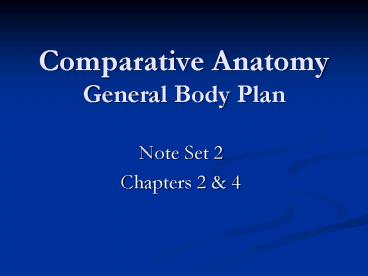Comparative Anatomy General Body Plan - PowerPoint PPT Presentation
1 / 19
Title:
Comparative Anatomy General Body Plan
Description:
Anamniotes (lower vertebrates)- have gill slits ... Coelom- body cavity between gut and body wall, lined by peritoneum. Figure 3.9: Coelom. ... – PowerPoint PPT presentation
Number of Views:304
Avg rating:3.0/5.0
Title: Comparative Anatomy General Body Plan
1
Comparative AnatomyGeneral Body Plan
Note Set 2 Chapters 2 4
2
Pharynx (fair-inks) with slits
- Figure 3.1 Pharyngeal arches
- lateral view and
- (b) ventral cross section.
- Pharyngeal arches- associated with slits
- Anamniotes (lower vertebrates)- have gill slits
- Amniotes- have slits in embryo but gills never
form - Endodermal pouches- pharyngeal pouch that grows
toward surface of animal - Ectodermal groove- pharyngeal groove on outside
that grows toward each pouch
3
Embryo
Figure 3.2 Embryo pharyngeal arches.
Figure 3.3 Embryo development at 1 month.
4
(a)
- In tetrapods, 1st pharyngeal slit becomes
auditory tube and middle ear cavity - Aortic arches housed by pharyngeal arch
(b)
Figure 3.4 Early pharyngeal devel.. of shark (a)
early stage (b) later stage.
5
Figure 3.5 Fate of the pharyngeal arches.
- 1st (mandibular) arch- mandibular and maxillary
portions - 2nd (hyoid) arch
- Other arches are numerically named
- Most vertebrates have 6 pairs of arches
6
Figure 3.6 Pharyngeal arches.
- Each pharyngeal arch contains a cartilage,
artery, mesoderm component, and cranial nerve.
7
Body Plan
- Head
- Trunk
- Tail
Figure 3.7 Sagittal section of craniate embryo.
8
Head
- Head
- Cephalization- development of sense organs
- Protective covering of dermal bone (not
replacement bone) or cartilage
Figure 3.8.
9
Trunk
- Somites- muscle masses beside notochord
embryonic structures that turn into bone - Coelom- body cavity between gut and body wall,
lined by peritoneum
Figure 3.10.
Figure 3.9 Coelom.
10
Trunk (cont.)
- Other visceral organ cavities
- Heart- pericardium
- Lungs- pleura
- Abdomen- peritoneum
Figure 3.12 Pericardium and pleural cavities.
Figure 3.11 Pericardium cavities.
11
Tail
- From body to end of the digestive tract
- Somites and notochord
- Innervations
- Dorsal and ventral aorta
- Food storage, defense, locomotion
12
Pituitary Development
Figure 3.13
- Stomodeal ectoderm plate pushes inward and forms
pocket (Rathkes pouch) that leads to anterior
lobe - This invagination meets the dienchephalons
infundibular process which forms the posterior
lobe
Figure 3.14
13
Characteristics of Vertebrates
- Divided into two superclasses Pisces and
Tetrapoda - Demonstrate bilateral symmetry
- Distinguishing features of vertebrates
- Presence of notochord
- Pharynx with slits
- Dorsal tubular nervous system
- Developed vertebrae
- Post anal tail
14
Notochord
- Most primitive endoskeletal structure
- Jawless fish- n.c. long and enlarged
- Cartilagenous fish- n.c. surrounded by
cartilagenous vertebrae - Bony fish and amphibians- n.c. surrounded by
larger vertebrae - Amniotes- n.c. almost lost
15
Notochord (cont.)
- In mammals, between successive centrum are disks
- Within disks, the notochord is mostly replaced
with pulpy nucleus
Figure 3.15 Vertebrae.
Figure 3.16 MRI scan of notochord.
16
More Vertebrate Features
- Dorsal Nervous System
- CNS- brain and spinal cord
- Anamniotes- 10 pairs of cranial nerves
- Amniotes- 12 pairs of cranial nerves
- Vertebrae column
- Backbones
- Post-anal tail
Figure 3.17 Vertebral column.
17
Anatomical Directions
Figure 3.18.
Figure 3.19.
18
Cranial Nerves
- Olfactory
- Optic
- Oculomotor
- Trochlear
- Trigeminal
- Abducens
- Facial
- Vestibulocochlear
- Glossopharyngeal
- Vagus
- Amniotes only
- Spinal Accessory
- Hypoglossal
Figure 3.20
19
Literature Cited
- Figure 3.1- http//www.nature.com/nrg/journal/v2/n
11/images/nrg1101-858a-i1.gif - Figure 3.2- http//www.ratbehavior.org/images/Embr
yoPharyngealArches.jpg - Figure 3.3- http//islam.org.hk/It_is_the_Truth/so
mites.htm - Figure 3.4, 3.7, 3.8, 3.10, 3.18- Kent, George
C. and Robert K. Carr. Comparative Anatomy of
the Vertebrates. 9th ed. McGraw-Hill, 2001. - Figure 3.5- http//pharyngula.org/images/arch_fate
s.gif - Figure 3.6- http//connection.lww.com/Products/sad
ler/imagebank.asp - Figure 3.9- http//www.sci.nu.ac.th/biology/elearn
ing/picture5/7_coelomate.jpg - Figure 3.11- http//mywebpages.comcast.net/wnor/th
oraxlesson4.htm - Figure 3.12- http//faculty.southwest.tn.edu/rburk
ett/AP20body20cavities.htm - Figure 3.13- http//people.musc.edu/wilburd/Head
20and20Neck20I/sld012.htm - Figure 3.14- http//www.cushings-help.com/rathke.h
tm - Figure 3.15- http//cal.vet.upenn.edu/saortho/chap
ter_62/62mast.htm - Figure 3.16- http//www.telepathology.com/cases/fo
rum/case17g.jpg - Figure 3.17- http//anthro.palomar.edu/primate/foo
tnote.htm - Figure 3.19- http//encyclopedia.thefreedictionary
.com/Terms20for20anatomical20location - Figure 3.20- http//www.besthealth.com/besthealth/
bodyguide/reftext/html/nerv_sys_fin.html































